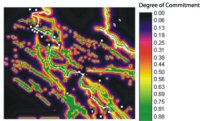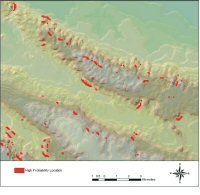
Figure 17: Belief image for the site hypothesis
In a previous work (Anaya Hernández 2001) one of my objectives was to identify the location of a Classic Maya kingdom of the Upper Usumacinta, which was known only by its emblem glyph: Sak Tzi'i', but whose whereabouts were unknown. I applied Dempster-Shafer logic to produce a site prediction model that would identify all the locations in the region where the likelihood of the presence of a major centre would be high. The parameters used then to evaluate this likelihood were: proximity to main routes of communication and distance from other major centres. This model is thoroughly described in the above-cited work, and the interested reader is referred to it. In this article I will limit myself to specifying the basic principles of Dempster-Shafer theory and delineate the criteria used in this case to identify the areas where there was a high likelihood of finding a strategically positioned secondary centre.
Dempster-Shafer theory belongs to a relatively recent development of Decision Support Systems in GIS known as Uncertainty Management. This differs from the more traditional approaches in GIS where the models and databases are implied to be 'perfect' thus leading us to take 'hard' decisions. Instead, Dempster-Shafer theory recognises as a working principle the concept of ignorance. For example, if we want to obtain a measure of the likelihood that an archaeological site will be found at a specific location, Dempster-Shafer logic creates a frame of discernment intended to exhaust all possible combinations of the variables involved. In this manner it takes into account ignorance by setting the variables in a frame of discernment that tests a 'site hypothesis', a 'non-site hypothesis', and the combination of both, 'site-non-site' (Clark Labs 1997).
Thus the strength of this approach lies not only in recognising these uncertainties, but also in providing us with the means to deal with them by the creation of three complementary measures of likelihood: Belief, Plausibility, and Belief-Interval. Belief constitutes the degree to which evidence provides support for a given hypothesis (in this case the presence of an archaeological site). Plausibility constitutes the measure to which the evidence does not refute that hypothesis. And finally, the Belief-Interval constitutes the difference between belief and plausibility, and it acts as a measure of uncertainty, thus allowing us to assess the degree of ignorance (Clark Labs 1997, 9.32, 9.37).
By comparing the various landscape attributes that other subsidiary sites in the region such as El Cayo, La Pasadita, La Mar, Panhalé, Cascada Lacanha, Chinikihá and San José have in common, the following variables were selected:

Figure 17: Belief image for the site hypothesis
In this case I want to emphasise the results obtained for Belief (Fig. 17). The value of the black to dark blue hues represent low values in terms of the degree of commitment to the 'site hypothesis', the red to orange, medium, and the green hues a high level of commitment to the 'site hypothesis'. In other words, the degree of commitment constitutes the measure in which a location in the landscape meets the criteria outlined above, thus increasing the likelihood that a centre of secondary importance will occur. For a better graphic representation, all the areas with a high value were isolated and overlaid on the DEM of the study area. The High Probability locations for the Redención del Campesino Valley are presented in Figure 18.

Figure 18: Dempster-Shafer results in the Redención del Campesino valley
The possibility of the existence of a site of such political importance is supported by a circumstantial source of evidence, the hieroglyphic record. This evidence is presented in the following section.
© Internet Archaeology/Author(s)
University of York legal statements | Terms and Conditions
| File last updated: Tue Mar 7 2006